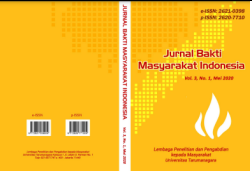PEMETAAN PROFIL ANTROPOMETRI, DAN BIOKIMIA DARAH SEBAGAI UPAYA PREVENTIF TERHADAP PENYAKIT TIDAK MENULAR DI KELURAHAN TOMANG JAKARTA BARAT
Main Article Content
Abstract
Increasing the welfare of the community has an impact on lifestyle changes such as low physical activity, high carbohydrate, and low diet. Along with these conditions, the incidence of non-communicable diseases (PTM / Non-Communicable Diseases / NCD) also increases. PTM includes cardiovascular disease, diabetes mellitus, lung disease, and cancer. WHO reports that each year PTM causes 35 million deaths worldwide, and many of these deaths occur in low-to-middle income economies. Obesity is one of the risk factors for PTM. Many residents of Tomang village are known to suffer from diabetes. Based on the above conditions, the Faculty of Medicine intends to carry out anthropometric and biochemical profiles to get a picture of the nutritional status and PTM in Tomang village. The invitation was distributed by cadres from Tomang Urban Village. On the day of implementation, participants registered and then filed out the questionnaire. Furthermore, participants were directed to anthropometric examination and continued with biochemical examination. This dedication activity involved the Tarumanagara University Faculty of Medicine students. From eighty-three residents, only 10.8% of residents had high blood pressure (hypertension), high blood sugar (GDS) (> 200 mg / dL) 4.8%, high cholesterol (> 200 mg / dL) 16 , 9%, and high uric acid (male> 7 mg / dL; female> 6 mg / dL) 25.3%. Based on the calculation of the Body Mass Index (BMI), it was found that more than sixty percent of the population had more nutritional status to fat. Continuous efforts are needed in the form of outreach to continue to increase community awareness and knowledge of PTM
ABSTRAK:
Peningkatan kesejahteraan masyarakat berdampak terhadap perubahan gaya hidup seperti aktifitas fisik yang rendah, pola makan tinggi energi dan rendah serta. Seiring dengan keadaan tersebut, insiden penyakit tidak menular (PTM/Non-Communicable Diseases/NCD) ikut meningkat. PTM mencakup penyakit kardiovaskuler, diabetes melitus, penyakit paru dan kanker. WHO melaporkan setiap tahunnya PTM menyebabkan 35 juta kematian di seluruh dunia, dan kematian ini banyak terjadi di negara berpendapatan ekonomi rendah hingga sedang. Obesitas merupakan salah satu faktor resiko terjadinya PTM. Banyak warga kelurahan Tomang diketahui menderita Diabetes. Berdasarkan kondisi diatas, Fakultas Kedokteran hendak melaksanakan pemeriksaan antropometri dan profil biokimia untuk mendapatkan gambaran mengenai status gizi dan PTM di kelurahan Tomang. Penyebaran undangan dilakukan oleh para kader dari Kelurahan Tomang. Pada hari pelaksanaan, peserta melakukan registrasi dan kemudian mengisi kuesioner. Selanjutnya peserta diarahkan untuk pemeriksaan antropometri, dan dilanjutkan dengan pemeriksaan biokimia. Kegiatan pengabdian ini melibatkan mahasiswa Fakultas Kedokteran Universitas Tarumanagara. Dari delapan puluh tiga warga, didapatkan hanya 10,8% warga yang tekanan darahnya tinggi (hipertensi), gula darah sewaktu (GDS) tinggi (>200 mg/dL) 4,8%, kolesterol tinggi (>200 mg/dL) 16,9%, dan asam urat tinggi (laki-laki >7 mg/dL; perempuan >6 mg/dL) 25,3%. Berdasarkan perhitungan Indeks Massa Tubuh (IMT), didapatkan lebih dari enampuluh persen warga memiliki status gizi lebih hingga gemuk. Diperlukan upaya berkelanjutan dalam bentuk penyuluhan untuk tetap meningkatkan kewaspadaan dan pengetahun masyarakat akan PTM
Article Details
This work is licensed under a Jurnal Bakti Masyarakat Indonesia https://creativecommons.org/licenses/by-nc-sa/4.0/
References
Alwan, A., & MacLean, D. R. (2009). A review of non-communicable disease in low- and middle-income countries. International Health, 1(1), 3–9. https://doi.org/10.1016/j.inhe.2009.02.003
Badan Penelitian dan Pengembangan Kesehatan Kementerian Kesehatan RI. (2013). RISET KESEHATAN DASAR RISKESDAS 2013. Jakarta. Retrieved from http://www.depkes.go.id/resources/download/general/Hasil Riskesdas 2013.pdf
Bickley, L. S., & Szilagyi, P. G. (2007). Bates’ Guide to Physical Examination and History Taking (9th ed.). Lippincott Williams & Wilkins.
CDC. (2007). Anthropometry Procedures Manual. Retrieved from https://www.cdc.gov/nchs/data/nhanes/nhanes_07_08/manual_an.pdf
Gibson, R. S. (2005). Principles of nutritional assessment. Oxford University Press.
Gowshall, M., & Taylor-Robinson, S. D. (2018). The increasing prevalence of non-communicable diseases in low-middle income countries: The view from Malawi. International Journal of General Medicine, 11, 255–264. https://doi.org/10.2147/IJGM.S157987 LK - http://link.kib.ki.se/?sid=EMBASE&issn=11787074&id=doi:10.2147%2FIJGM.S157987&atitle=The+increasing+prevalence+of+non-communicable+diseases+in+low-middle+income+countries%3A+The+view+from+Malawi&stitle=Int.+J.+Gen.+Med.&title=International+Journal+of+General+Medicine&volume=11&issue=&spage=255&epage=264&aulast=Gowshall&aufirst=Matthew&auinit=M.&aufull=Gowshall+M.&coden=&isbn=&pages=255-264&date=2018&auinit1=M&auinitm=
Kementerian Badan Penelitian dan Pengembangan Kesehatan. (2018). HASIL UTAMA RISKESDAS 2018 Kesehatan, 20–21.
WHO. (2014). Non communicable Diseases Country Profiles. World Health Organization, 1–210. https://doi.org/10.1111/jgs.12171
World Health Organization. (n.d.). GLOBAL STATUS REPORT on noncommunicable diseases 2014. Retrieved from http://apps.who.int/iris/bitstream/handle/10665/148114/9789241564854_eng.pdf?sequence=1


